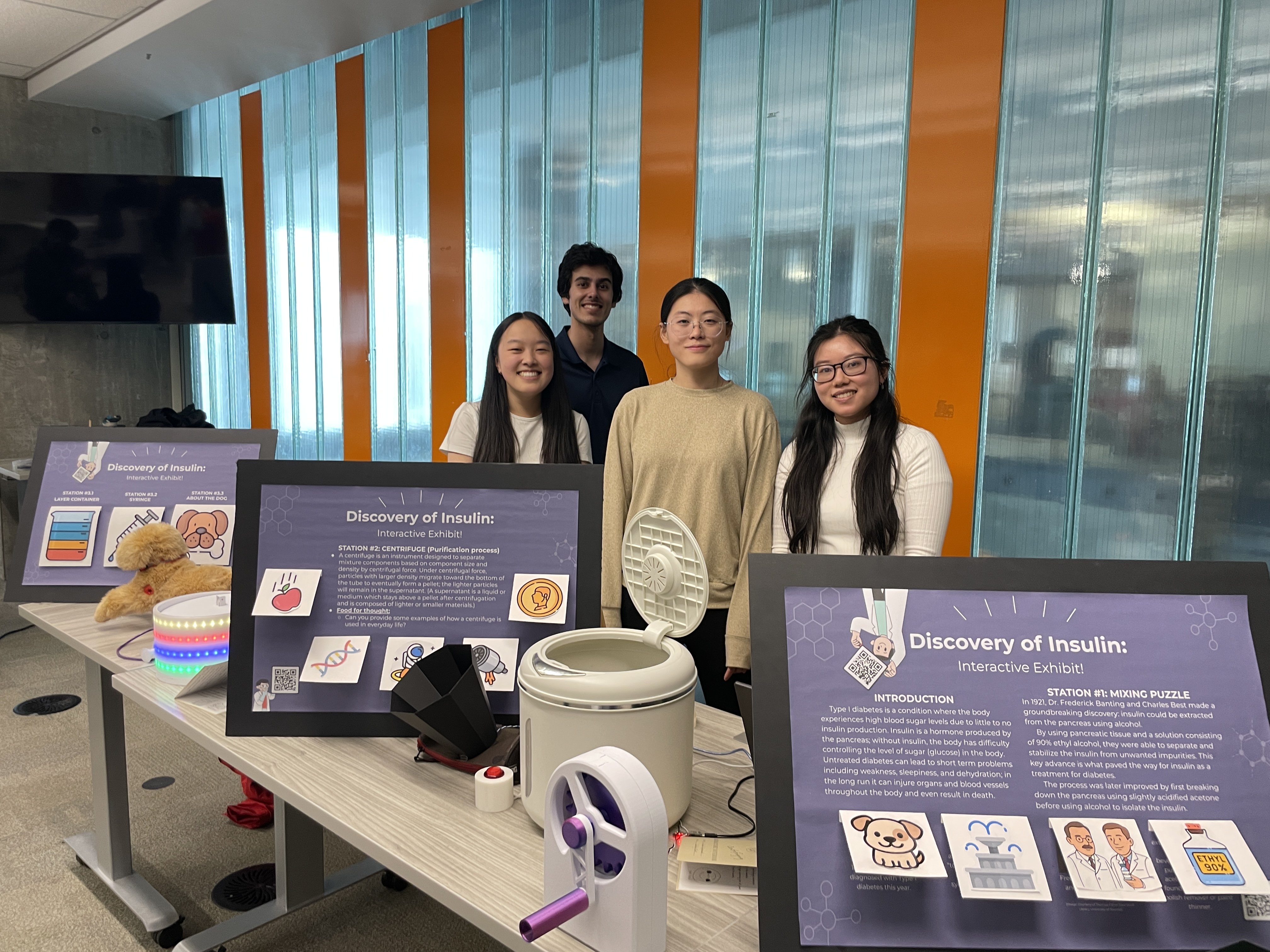Project Overview
The concept of this interactive exhibit is to put users in the shoes of Banting and Best, and try out some of the necessary steps they took to extract insulin.

Our exhibit is divided into 3 stations, with each one representing a major step Banting and Best took when they first extracted medical insulin. These stations contain interactive gadgets custom designed by us to simulate what is was like to be a scientist in 1921 and discover insulin. Our goal was for particpants to learn all about the history of insulin and how it was made while having fun in an interactive way. These gadgets involve various technologies such as microcontrollers, motorized servos, LED strips, audio speakers, and many contraptions modelled and 3D printed by us.
Each station also has educational info in the form of detailed posters describing how the current station relates to real world history, giving partipants the opportunity to learn more if they so choose. In addition, we also have an audio voiceover that guides the particpants from the beginning of our exhibit to the very end, walking them through and giving tips they progressed. Lastly, we included small instructional booklets for each station that have detailed written instructions if needed. (Click here for more info)
An in-depth description and video demonstration of each station is shown below, walking you through our entire exhibit.
Station 1: Mixing Puzzle
In order to extract insulin, a solution was needed involving alcohol and acetone in order to stabalize the insulin and prevent it from breaking down. To represent this initial step, we developed a mixing puzzle where particpants are tasked with properly mixing two solutions together. Here, we have 3 flasks of varying sizes with rows of LED strips inside each, where each row lit up represents 1 litre. The goal is to acheive 4 litres inside the largest flask. Particpants are able to pick up the flasks and tap them together, transferring all of the solution from one flask to the other. By completing this station, particpants will feel a sense of accomplishment and gain a greater understanding as to what Banting and Best had originally accomplished when they first developed this process. (Click here for more info)
Station 2: Centrifuge
The next major step in extracting insulin is to separate it from the rest of the solution that was developed in the first station. Normally this is done with a centrifuge such that by spinning the solution so fast, the different chemicals in the solution separate from each other into different layers. To represent this step in our exhibit, we created our own custom made centrifuge and hand crank. Particpants are tasked with inserting vials into the centrifuge and turning our hand crank to operate the spinning mechanism. Note however that the hand crank and centrifuge are not physically attached. Instead we use a sensor to detect the hand crank’s rate of motion which tells an electronic motor in the centrifuge how fast to spin. After finishing this station, particpants would have learned and experienced what it is truly like to use a centrifuge. (Click here for more info)
Station 3: Layer Container and Dog
After centrifuging the solution in the previous station, it has now separated into four distinct layers. However, only a single layer contains insulin. To simulate this process of choosing the right layer, we created a large cylindrical container we call the layer container. This large container represents an oversized version of the centrifuged solution from the previous station. It has four rows of LED strips surrounding it, representing the four different layers in the soultion. After listening to hints from our audio voiceover, users can select which layer they want to use by using a custom made syringe that pushes down on a pressure loaded plate that determines which layer is being selected. (Click here for more info)
In real life, Banting and Best tested on various dogs ill with diabetes to determine if the insulin they developed truly worked. To recreate this final step, we took a dog puppet and turned it into an animatronic test subject. Using the solution extracted from the layer container, particpants are able to simulate injecting our animatronic dog Majorie. If the right layer was chosen, Majorie will wake up and bark with joy. If the wrong layer was chosen, partipants must go back to the layer container to try a different layer. By completeing this station, participants will have fully reinacted some of the major steps in discovering insulin and will have gained insight into how Banting and Best did it in Toronto all those years ago. (Click here for more info)